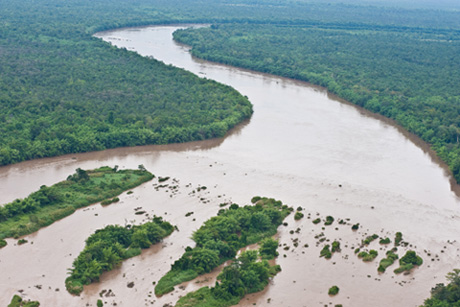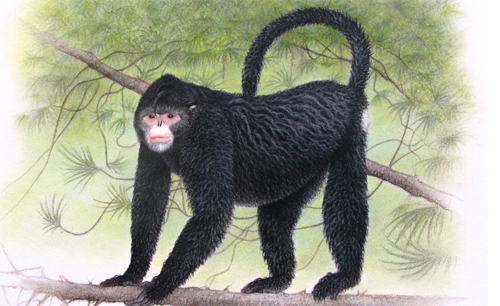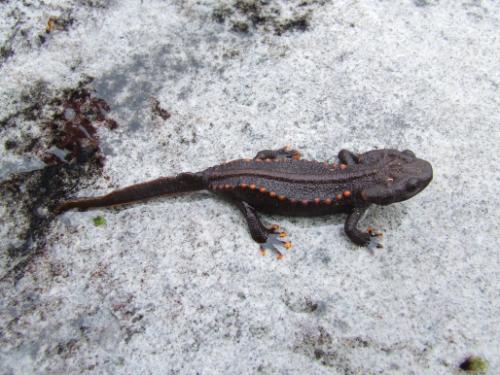Navigation
New Species Discovered In The Mekong River Region
A new monkey, a self-cloning skink, five carnivorous plants, and a unique leaf warbler are among the 208 species newly described by science in the Greater Mekong region in 2010 and highlighted in a new WWF report, Wild Mekong.
 The Mekong River: The Mekong winds 4,800 kilometers down to the South China Sea Photograph © WWF Greater Mekong
The Mekong River: The Mekong winds 4,800 kilometers down to the South China Sea Photograph © WWF Greater Mekong Monkey, Rhinopithecus strykeri: While this species, sporting an Elvis-like hairstyle, is new to science, the local people of Myanmar know it well. Scientists first learned of “Snubby” - as they nicknamed the species - from hunters in Myanmar’s forested, remote, and mountainous (Himalayan) Kachin state in early 2010. Image by and © Martin Aveling/Fauna & Flora International.
Monkey, Rhinopithecus strykeri: While this species, sporting an Elvis-like hairstyle, is new to science, the local people of Myanmar know it well. Scientists first learned of “Snubby” - as they nicknamed the species - from hunters in Myanmar’s forested, remote, and mountainous (Himalayan) Kachin state in early 2010. Image by and © Martin Aveling/Fauna & Flora International.
A new monkey, a self-cloning skink, five carnivorous plants, and a unique leaf warbler are among the 208 species newly described by science in the Greater Mekong region in 2010 and highlighted in a new WWF report, Wild Mekong.
The report affirms the Mekong as a region of extraordinary biodiversity. WWF called on the six leaders from the Greater Mekong Sub-region (GMS) to put the benefits of biodiversity, and the costs of losing it, at the center of decision-making and regional cooperation.  New orchid find, Dendorbium dalakense: 145 plants were discovered in the Greater Mekong in 2010. A beautiful orchid, with thick glossy white and orange flowers, was newly identified after being collected by a local plant hunter and handed to orchid experts at Kew Botanical Gardens in London, England. The forests of the Greater Mekong harbour a rich variety of flowering plants. Orchids are the prime example of this plant diversity: 16 new orchid species from the Greater Mekong were officially described in 2010. Photograph by and © L. Lee GrismerThe Myanmar summit endorsed a new strategy guiding the next decade of economic cooperation among the GMS countries agreeing on a new 10-year plan to boost growth, development and poverty reduction across the GMS. WWF presented the case at the summit that the Greater Mekong’s valuable natural assets and species will continue to disappear without accelerated efforts to green the region’s economies.
New orchid find, Dendorbium dalakense: 145 plants were discovered in the Greater Mekong in 2010. A beautiful orchid, with thick glossy white and orange flowers, was newly identified after being collected by a local plant hunter and handed to orchid experts at Kew Botanical Gardens in London, England. The forests of the Greater Mekong harbour a rich variety of flowering plants. Orchids are the prime example of this plant diversity: 16 new orchid species from the Greater Mekong were officially described in 2010. Photograph by and © L. Lee GrismerThe Myanmar summit endorsed a new strategy guiding the next decade of economic cooperation among the GMS countries agreeing on a new 10-year plan to boost growth, development and poverty reduction across the GMS. WWF presented the case at the summit that the Greater Mekong’s valuable natural assets and species will continue to disappear without accelerated efforts to green the region’s economies.
“Mekong governments have to stop thinking about biodiversity protection as a cost and recognize it as an investment to ensure long-term stability,” said Stuart Chapman, Conservation Director of WWF Greater Mekong. “It is ultimately this natural capital upon which the Greater Mekong’s prosperity is built.”
Among the ten species highlighted in the WWF report is the snub-nosed monkey (Rhinopithecus strykeri). Found in Myanmar’s remote and mountainous Kachin state, locals say the monkey can be spotted with its head between its knees in wet weather to avoid rain running into its upturned nose.
 Vibrantly-spotted newt species, Tylototriton notialis: A new species of newt was discovered in Laos in 2010. The new species is particularly significant as it represents the first record of a species from the genus Tylototriton from Laos, and is the southernmost known member of the Tylototriton asperrimus group in the world. The Latin name for the species, notialis meaning “southern,” refers to this. Scientists fear that over- harvesting for traditional medicine and the international pet trade may put the species at heightened risk. The formal description of other Asian salamandrids in the past (Laotrian laoensis; Stuart and Papenfuss 2002) has inadvertently led to exploitation for the international pet trade. Hopefully the Theun National Protected Area, one of Laos’ largest and best-funded national protected areas, will afford this endemic species some protection. Photograph by and © Bryan Stuart.
Vibrantly-spotted newt species, Tylototriton notialis: A new species of newt was discovered in Laos in 2010. The new species is particularly significant as it represents the first record of a species from the genus Tylototriton from Laos, and is the southernmost known member of the Tylototriton asperrimus group in the world. The Latin name for the species, notialis meaning “southern,” refers to this. Scientists fear that over- harvesting for traditional medicine and the international pet trade may put the species at heightened risk. The formal description of other Asian salamandrids in the past (Laotrian laoensis; Stuart and Papenfuss 2002) has inadvertently led to exploitation for the international pet trade. Hopefully the Theun National Protected Area, one of Laos’ largest and best-funded national protected areas, will afford this endemic species some protection. Photograph by and © Bryan Stuart.
A staggering array of 28 reptiles was also newly discovered in 2010, including an all-female lizard (Leiolepis ngovantrii) in Vietnam that reproduces via cloning without the need for male lizards.
Nepenthes holdenii, a carnivorous pitcher plant: Some species of Nepenthes can grow to a maximum height of 100 cm with vines exceeding 25 cm high. Botanical experts say that they can actually lure in and consume small rats, mice, lizards and even birds. Nepenthes holdenii is known to exist on two peaks in the Cardamom Mountains of western Cambodia. Photograph by and © François MeyFive species of carnivorous pitcher plants were also discovered across Thailand and Cambodia, with some species capable of luring in and consuming small rats, mice, lizards and even birds.
“While the 2010 discoveries are new to science, many are already destined for the dinner table, struggling to survive in shrinking habitats and at risk of extinction,” added Chapman.
The extinction of the Javan rhino in Vietnam, recently confirmed by WWF, is one tragic indicator of the decline of biodiversity in the region. The Mekong’s wild places and wildlife are under extreme pressure from rapid, unsustainable development and climate change.
“The region’s treasure trove of biodiversity will be lost if governments fail to invest in the conservation and maintenance of biodiversity, which is so fundamental to ensuring long-term sustainability in the face of global environmental change,” concluded Chapman.
 The Mekong River: The Mekong winds 4,800 kilometers down to the South China Sea Photograph © WWF Greater Mekong
The Mekong River: The Mekong winds 4,800 kilometers down to the South China Sea Photograph © WWF Greater Mekong
Wild Mekong, the fourth in a series of reports highlighting new species discoveries in the Greater Mekong region, spotlights 10 species newly identified by science, among the 145 plants, 28 reptiles, 25 fish, 7 amphibians, 2 mammals, and 1 bird all discovered in 2010 within the Greater Mekong region of Southeast Asia that spans Cambodia, Laos, Myanmar, Thailand, Vietnam and the south-western Chinese province of Yunnan. The report reveals an average of one new species recorded by science every two days in the region.
 346_edited-2.jpg) Psychedelic gecko, Cnemaspis psychedelica: A new psychedelic gecko species was recently discovered on Hon Khoai Island, Ca Mau Province, Ngoc Hien District, 18 km off the southern tip of the Ca Mu Peninsula in southern Vietnam. The species is unique in that it displays a remarkable psychedelic pattern of bright orange appendages; a dense, yellow neck overlying thick, black, lines; and a blue-gray body bearing yellow bars on its bright-orange sides. Cnemaspis psychedelica is known only from the tiny (roughly 8 km2) Hon Khoai Island. The island reaches approximately 320m at its highest point, with thick forest cover sloping gently down to a mangrove-lined coast. Scattered across the lowlands of the island are small to massive boulders that provide the habitat for Cnemaspis psychedelica. Photograph by and © L. Lee Grismer.
Psychedelic gecko, Cnemaspis psychedelica: A new psychedelic gecko species was recently discovered on Hon Khoai Island, Ca Mau Province, Ngoc Hien District, 18 km off the southern tip of the Ca Mu Peninsula in southern Vietnam. The species is unique in that it displays a remarkable psychedelic pattern of bright orange appendages; a dense, yellow neck overlying thick, black, lines; and a blue-gray body bearing yellow bars on its bright-orange sides. Cnemaspis psychedelica is known only from the tiny (roughly 8 km2) Hon Khoai Island. The island reaches approximately 320m at its highest point, with thick forest cover sloping gently down to a mangrove-lined coast. Scattered across the lowlands of the island are small to massive boulders that provide the habitat for Cnemaspis psychedelica. Photograph by and © L. Lee Grismer.
The initial report on new species discoveries in the Greater Mekong region, First Contact, was released in December 2008 and showcased the discovery of over 1000 new species discoveries in the region between 1997 and 2007. In total, 1584 species in the Greater Mekong have been newly described by science between 1997 and 2010.
This news is from WWF http://wwf.panda.org/
 Limestone Leaf-Warbler, Phylloscopus calciatilis: In January 2010, a small, distinctive bird living in the rocky forests of the Annamite mountain range in Laos and Vietnam was described for the first time. It is similar to other warblers in this area of Southeast Asia, except for its distinct vocalizations and slight morphological differences. The tiny bird is greenish-olive with a yellow breast and striped crown. It has a loud and unique call, which is what first alerted the researchers that the bird may be new to science. Photograph by and © Ulf Johansson/ Swedish Museum of Natural History
Limestone Leaf-Warbler, Phylloscopus calciatilis: In January 2010, a small, distinctive bird living in the rocky forests of the Annamite mountain range in Laos and Vietnam was described for the first time. It is similar to other warblers in this area of Southeast Asia, except for its distinct vocalizations and slight morphological differences. The tiny bird is greenish-olive with a yellow breast and striped crown. It has a loud and unique call, which is what first alerted the researchers that the bird may be new to science. Photograph by and © Ulf Johansson/ Swedish Museum of Natural History
The Greater Mekong
WWF says, “Imagine a place where tigers still roam wild and new species are discovered every week - this is the Greater Mekong. The Greater Mekong spans Cambodia, Laos, Myanmar, Thailand, Vietnam and the southern province of Yunnan in China, and contains some of the most biologically diverse habitats on our planet.
“Since 1997, over 1500 new species have been described by science in the jungles, rivers and even urban areas of the Greater Mekong. This is in addition to a number of rare species including crested gibbon, tigers, Mekong Irrawaddy dolphin and the elusive Saola, which has been described as the most remarkable large mammal discovery of the last 70 years.”
Mekong Leaders Agree on Wide-Ranging Development Plan for Next Decade
At the conclusion of the 4th Greater Mekong Subregion (GMS) Summit on 20 December 2011, leaders of the six nations that share the Mekong River agreed on a new 10-year plan to boost growth, development and poverty reduction across the GMS.
In a joint declaration issued at the conclusion of the Summit, GMS leaders endorsed a strategic framework for 2012 to 2022 that calls for a range of new measures to strengthen regional cooperation, including more effective resource utilization and more careful balancing of development with environmental concerns.
“The new Strategic Framework for 2012-2022 will move the GMS to the next level through multisector investment projects, policy development, and inter-sector coordination,” said Asian Development Bank (ADB) President Haruhiko Kuroda.
GMS leaders also endorsed strategies to enhance agricultural development, including food safety and security; accelerate the development and implementation of the pro-poor sustainable tourism industry, with the creation of multi-country tour packages to help spread revenues more widely; and promote low-carbon development and enhance management of the sub-region’s richly diverse ecosystems.
Since its inception in 1992, the GMS program has helped bring an area once divided by conflict increasingly together with investments of about $14 billion in projects with broad subregional benefits, including roads, airports and railways; telecommunications; energy; urban development; tourism; environmental protection; and the prevention of communicable diseases.
Since the start of the economic cooperation program, gross domestic product growth in the subregion has averaged about 8% a year, while real per capita incomes more than tripled between 1993 and 2010. As of September 2011, ADB assistance for the program totaled about $5 billion.
GMS members include Cambodia, Lao People’s Democratic Republic, Myanmar, Thailand, Viet Nam, and Yunnan province and the Guangxi autonomous region in the People’s Republic of China.
This news is from the Asian Development Bank (ADB), 20 December 2011
Search
Latest articles
Agriculture
- World Water Week: Healthy ecosystems essential to human health: from coronavirus to malnutrition Online session Wednesday 24 August 17:00-18:20
- World Water Week: Healthy ecosystems essential to human health: from coronavirus to malnutrition Online session Wednesday 24 August 17:00-18:20
Air Pollution
- "Water and Sanitation-Related Diseases and the Changing Environment: Challenges, Interventions, and Preventive Measures" Volume 2 Is Now Available
- Global Innovation Exchange Co-Created by Horizon International, USAID, Bill and Melinda Gates Foundation and Others
Biodiversity
- It is time for international mobilization against climate change
- World Water Week: Healthy ecosystems essential to human health: from coronavirus to malnutrition Online session Wednesday 24 August 17:00-18:20
Desertification
- World Water Week: Healthy ecosystems essential to human health: from coronavirus to malnutrition Online session Wednesday 24 August 17:00-18:20
- UN Food Systems Summit Receives Over 1,200 Ideas to Help Meet Sustainable Development Goals
Endangered Species
- Mangrove Action Project Collaborates to Restore and Preserve Mangrove Ecosystems
- Coral Research in Palau offers a “Glimmer of Hope”
Energy
- Global Innovation Exchange Co-Created by Horizon International, USAID, Bill and Melinda Gates Foundation and Others
- Wildlife Preservation in Southeast Nova Scotia
Exhibits
- Global Innovation Exchange Co-Created by Horizon International, USAID, Bill and Melinda Gates Foundation and Others
- Coral Reefs
Forests
- NASA Satellites Reveal Major Shifts in Global Freshwater Updated June 2020
- Global Innovation Exchange Co-Created by Horizon International, USAID, Bill and Melinda Gates Foundation and Others
Global Climate Change
- It is time for international mobilization against climate change
- It is time for international mobilization against climate change
Global Health
- World Water Week: Healthy ecosystems essential to human health: from coronavirus to malnutrition Online session Wednesday 24 August 17:00-18:20
- More than 400 schoolgirls, family and teachers rescued from Afghanistan by small coalition
Industry
- "Water and Sanitation-Related Diseases and the Changing Environment: Challenges, Interventions, and Preventive Measures" Volume 2 Is Now Available
- Global Innovation Exchange Co-Created by Horizon International, USAID, Bill and Melinda Gates Foundation and Others
Natural Disaster Relief
- STOP ATTACKS ON HEALTH CARE IN UKRAINE
- Global Innovation Exchange Co-Created by Horizon International, USAID, Bill and Melinda Gates Foundation and Others
News and Special Reports
- World Water Week: Healthy ecosystems essential to human health: from coronavirus to malnutrition Online session Wednesday 24 August 17:00-18:20
- STOP ATTACKS ON HEALTH CARE IN UKRAINE
Oceans, Coral Reefs
- World Water Week: Healthy ecosystems essential to human health: from coronavirus to malnutrition Online session Wednesday 24 August 17:00-18:20
- Mangrove Action Project Collaborates to Restore and Preserve Mangrove Ecosystems
Pollution
- Zakaria Ouedraogo of Burkina Faso Produces Film “Nzoue Fiyen: Water Not Drinkable”
- "Water and Sanitation-Related Diseases and the Changing Environment: Challenges, Interventions, and Preventive Measures" Volume 2 Is Now Available
Population
- "Water and Sanitation-Related Diseases and the Changing Environment: Challenges, Interventions, and Preventive Measures" Volume 2 Is Now Available
- "Water and Sanitation-Related Diseases and the Changing Environment: Challenges, Interventions, and Preventive Measures" Volume 2 Is Now Available
Public Health
- Honouring the visionary behind India’s sanitation revolution
- Honouring the visionary behind India’s sanitation revolution
Rivers
- World Water Week: Healthy ecosystems essential to human health: from coronavirus to malnutrition Online session Wednesday 24 August 17:00-18:20
- Mangrove Action Project Collaborates to Restore and Preserve Mangrove Ecosystems
Sanitation
- Honouring the visionary behind India’s sanitation revolution
- Honouring the visionary behind India’s sanitation revolution
Toxic Chemicals
- "Water and Sanitation-Related Diseases and the Changing Environment: Challenges, Interventions, and Preventive Measures" Volume 2 Is Now Available
- Actions to Prevent Polluted Drinking Water in the United States
Transportation
- "Water and Sanitation-Related Diseases and the Changing Environment: Challenges, Interventions, and Preventive Measures" Volume 2 Is Now Available
- Urbanization Provides Opportunities for Transition to a Green Economy, Says New Report
Waste Management
- Honouring the visionary behind India’s sanitation revolution
- Honouring the visionary behind India’s sanitation revolution
Water
- Honouring the visionary behind India’s sanitation revolution
- Honouring the visionary behind India’s sanitation revolution
Water and Sanitation
- Honouring the visionary behind India’s sanitation revolution
- Honouring the visionary behind India’s sanitation revolution

